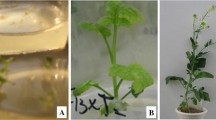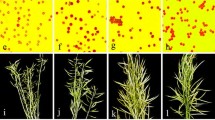Abstract
Gene transferability from transgenic rapeseed to various subspecies and varieties of Brassica rapa was assessed in this study. Artificial crossability was studied in 118 cultivars of 7 B. rapa subspecies and varieties with the transgenic rapeseed GT73 (Brassica napus) as the pollen donor. On average 5.7 seeds were obtained per pollination, with a range from 0.05 to 19.4. The heading type of B. rapa L. showed significantly higher crossability than non-heading types of B. rapa. The spontaneous outcrossing rate between B. rapa (female) and the transgenic rapeseed Ms8 × Rf3 (B. napus) (male) ranged from 0.039 to 0.406%, with an average of 0.19%. The fertilization process and the development of the hybrid seeds as shown by fluorescent staining techniques indicated that the number of adhered pollens on the stigma was reduced by 80%, the number of pollen tubes in the style was reduced by 2/3 and the fertilization time was delayed by over 20 h when pollinated with the transgenic rapeseed Ms8 × Rf3 in comparison with the bud self-pollination of B. rapa as control. About 10–70% of the interspecific hybrid embryos were aborted in the course of development. Some seeds looked cracked in mature pods, which showed germination abilities lower than 10%. The spontaneous outcrossing rates were much lower than the artificial crossability, and their survival fitness of the interspecific hybrid was very low, indicating that it should be possible to keep the adventitious presence of the off-plants under the allowed threshold, if proper measures are taken.





Similar content being viewed by others
References
Baranger A, Chever AM, Eber F, Renard M (1995) Effect of oilseed rape genotype on the spontaneous hybridization rate with weedy species: an assessment of transgene dispersal. Theor Appl Genet 91(6–7):956–963. doi:10.1007/BF00223906
Bing DJ, Downey RK, Rakow GFW (1996) Hybridization among Brassica napus, B. rapa and B. juncea and their two weedy relatives B. nigra and Sinpis arvensis under open pollinations in the field. Plant Breed 115:470–473. doi:10.1111/j.1439-0523.1996.tb00959.x
Black M (1991) Involvement of ABA in the physiology of developing and mature seeds. In: Daviesa WJ, Jones HG (eds) Abscisic acid: physiology and biochemistry. Bios Scientific, Oxford, pp 99–124
Brown AP (1995) Gene transfer between Canola (B. napus and B. campestris) and related weed species. In: Proceedings of 9th International Rapeseed Congress, Cambridge, UK, 4: 1445–1447
Christiansen FB, Andreasen V, Poulsen ET (1995) Genotypic proportions in hybrid zones. J Mathemat Biol 33:225–249
Eastham K, Sweet J (2002) Genetically modified organisms (GMOs): the significance of gene flow through pollen transfer. Environmental issue report no 28. European environmental agency. http://www.ewindows.eu.org/Agriculture/GMOs/gmospollen
Ellstrand NC, Hoffman CA (1990) Hybridization as an avenue of escape for engineered genes. Bioscience 40:438–442. doi:10.2307/1311390
Frello S, Hansen KR, Jensen J, Jorgensen RB (1995) Inheritance of rapeseed (Brassica napus) specific RAPD markers and a transgene in the cross B. juncea × (B. juncea × B. napus). Theor Appl Genet 91:236–241. doi:10.1007/BF00220883
Halfhill MD, Richards HA, Mabon SA, Stewart CNJ (2001) Expression of GFP and Bt transgenes in Brassica napus and hybridization and introgression with Brassica rapa. Theor Appl Genet 103:362–368. doi:10.1007/s001220100613
Halfhill MD, Millwood RJ, Raymer PL, Stewart CNJ (2002) Bt transgenic oilseed rape hybridization with its weedy relative, Brassica rapa. Environ Biosafety Res 1:19–28. doi:10.1051/ebr:2002002
Hansen LB, Siegismund HR, Jorgenson RB (2001) Introgression between oilseed rape (Brassica napus L.) and its weedy relative B. rapa L. in a natural population. Genet Resour Crop Evol 48:621–627. doi:10.1023/A:1013825816443
Hauser TP, Ostergard H (1999) Precocious germination of Brassica rapa × B. napus seeds within pods. Hereditas 130:89–93. doi:10.1111/j.1601-5223.1999.00089.x
Hauser TP, Shaw RG, Ostergard H (1998a) Fitness of F 1 hybrids between weedy Brassica rapa and oilseed rape (B. napus). Heredity 81:429–435. doi:10.1046/j.1365-2540.1998.00424.x
Hauser TP, Shaw RG, Ostergard H (1998b) Fitness of backcross and F2 hybrids between weedy Brassica rapa and oilseed rape (B. napus). Heredity 81:436–443. doi:10.1046/j.1365-2540.1998.00425.x
Hu SY (1994) Method of preparation of slides used to examine the pollen germination on the stigma and pollen tube growth in the style. Chin Bulletion Bot 11:58–60
Jorgensen RB, Andersen B (1994) Spontaneous hybridization between oilseed rape (Brassica napus) and weedy B. Campestris: a risk of growing genetically modified oilseed rape. Am J Bot 81(12):1620–1626. doi:10.2307/2445340
Jorgensen RB, Anderson B, landbe L, Mikkelsen TR (1996) Spontaneous hybridization between oilseed rape (Brassica napus) and weedy relatives. Acta Hortic 407(1–2):193–200
Levin DA (1978) The origin of isolating mechanisms in flowering plants. Evol Biol 11:185–317
Li J, Guan CY, Li X, Chen SY, Zheng Z, Chen PP (2006) Barstargene transfer from transgenic rapeseed to relatives. J Hunan Agric Univ 32(6):591–595
Lu CM, Kato M (2001) Fertilization fitness and relation to chromosome number in interspecific progeny between Brassica napus and B. rapa: a comparative study using natural and resynthesized B. napus. Breed Sci 51:73–81. doi:10.1270/jsbbs.51.73
Lu CM, Shen FS, Hu K (2001) Interspecific heterosis in hybrids between Brassica napus and B. rapa Sabrai. J Genet Breed 30:73–86
Lu CM, Kato M, Kakihara F (2002) Destiny of a transgene escape from Brassica napus to B. rapa. Theor Appl Genet 105:78–84. doi:10.1007/s00122-001-0856-2
Meng JL (1990) Studies on pollen-pistil interaction between Brassica napus and its relative species and genus. Acta Agronomica Sin 16(1):19–25
Messeguer J (2003) Gene flow assessment in transgenic plants. Plant Cell 73:201–212
Metz PLJ, Jacobsen E, Nap JP, Pereira A, Stiekema WJ (1997) The impact on biosafety of the phosphinothricin-tolerance transgene in inter-specific B. rapa × B. napus hybrids and their successive backcrosses. Theor Appl Genet 95:442–450. doi:10.1007/s001220050581
Mikkelsen TR, Andersen B, Jorgensen RB (1996) The risk of crop transgene spread. Nature 380:31. doi:10.1038/380031a0
Paul EM, Thompson C, Dunwell JM (1995) Gene dispersal from genetically modified oil seed rape in the field. Euphytica 81:283–289. doi:10.1007/BF00025619
Phillips J, Artsaenko O, Fiedler U, Horstmann C, Mock H, Müntz K, Conrad U (1997) Seed-specific immunomodulation of abscisic acid activity induces a developmental switch. EMBO J 16:4489–4496. doi:10.1093/emboj/16.15.4489
Raybould AF, Gray AJ (1993) Genetically modified crops and hybridization with wild relatives: a UK perspective. J Appl Ecol 30:199–219. doi:10.2307/2404623
Raybould AF, Gray AJ (1994) Will hybrids of genetically modified crops invade natural communities? Trends Ecol Evol 9:85–89. doi:10.1016/0169-5347(94)90201-1
Rieger MA, Preston C, Powles SB (1999) Risks of gene flow from transgenic herbicide-resistant oilseed rape (Brassica napus) to weedy relatives in southern Australian cropping systems. Aust J Agric Res 50:115–128. doi:10.1071/A97138
Scheffler JA, Parkinson R, Dale PJ (1995) Evaluating the effectiveness of isolation distances for field plots of oilseed rape (Brassica napus) using a herbicide-resistance transgene as a selectable marker. Plant Breed 114:317–321. doi:10.1111/j.1439-0523.1995.tb01241.x
Scott SE, Wilkinson MJ (1998) Transgene risk is low. Nature 393:320. doi:10.1038/30642
Snow AA, Palma PM (1997) Commercialization of transgenic plants: potential ecological risks. Bioscience 47:86–96. doi:10.2307/1313019
Snow AA, Andersen B, Jorgensen RB (1999) Costs of transgenic herbicide resistance introgressed from Brassica napus into weedy B. rapa. Mol Ecol 8:605–615. doi:10.1046/j.1365-294x.1999.00596.x
Staniland BK, McVetty PBE, Friesen LF, Yarrow S, Freyssinet G, Freyssinet M (2001) Effectiveness of border areas in confining the spread of transgenic Brassica napus pollen. Can J Plant Sci 80:521–526
Stebbins GL (1958) The inviability, weakness, and sterility of interspecific hybrids. Adv Genet 9:147–215. doi:10.1016/S0065-2660(08)60162-5
Zhao XX, Lu WP, Qi CK, Pu HM, Xia QX, Lu DL, Liu GS, Wang YP (2005) Assessment on alien herbicide-resistant gene flow among crucifers by sexual compatibility. Chin Sci Bull 50(15):1604–1611. doi:10.1360/982005-621
Acknowledgments
This study was supported by the Major Special Project for Development of Transgenic Organisms (2008–2010), Ministry of Agriculture, China and the Social Welfare Project on Environmental Protection, Ministry of Environmental Protection, China (2009–2011).
Author information
Authors and Affiliations
Corresponding authors
Rights and permissions
About this article
Cite this article
Xiao, L., Lu, C., Zhang, B. et al. Gene transferability from transgenic Brassica napus L. to various subspecies and varieties of Brassica rapa . Transgenic Res 18, 733–746 (2009). https://doi.org/10.1007/s11248-009-9261-4
Received:
Accepted:
Published:
Issue Date:
DOI: https://doi.org/10.1007/s11248-009-9261-4




